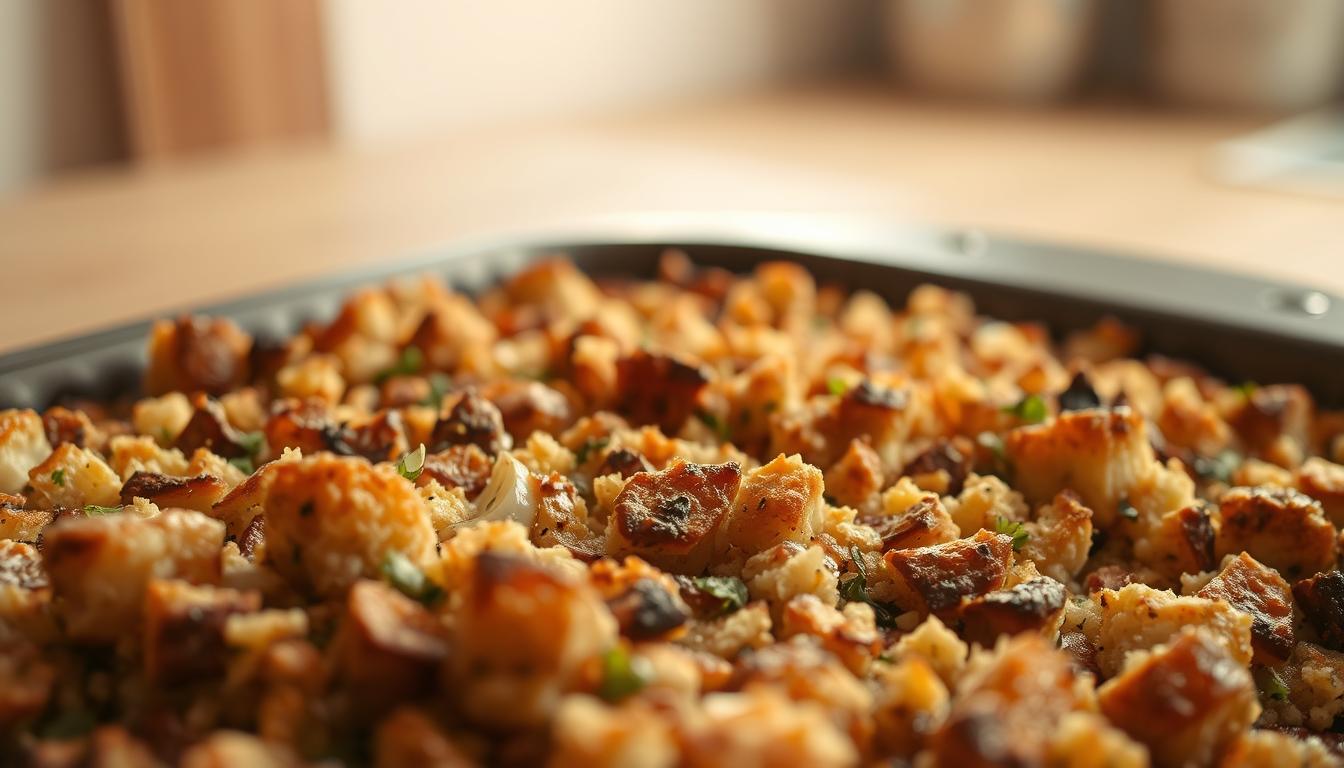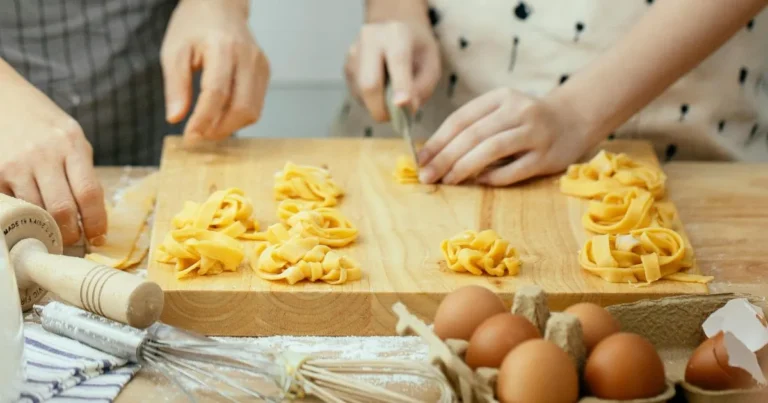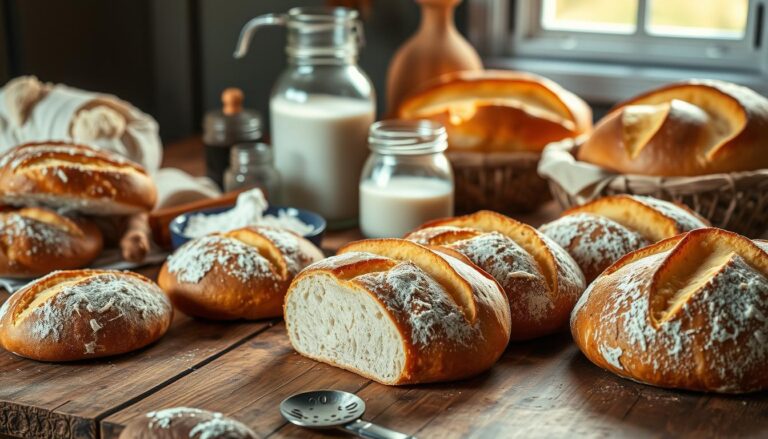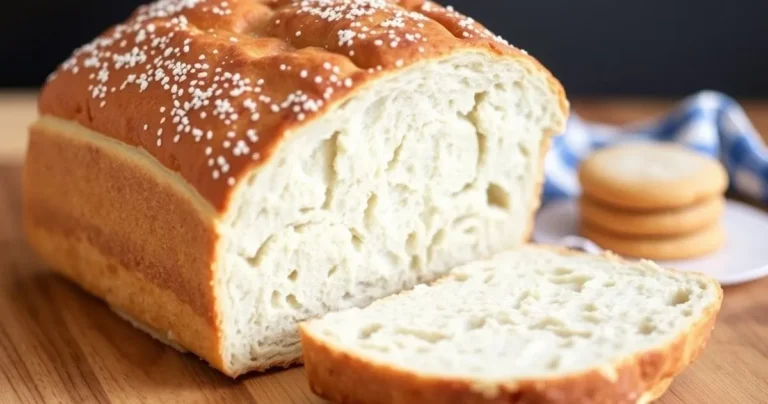How to Make Sourdough Stuffing (Step-by-Step Guide)
Every Thanksgiving, my grandmother’s kitchen was filled with amazing smells. Her homemade sourdough stuffing was at the center of it all. She would tear sourdough bread, mix it with herbs, and create a dish full of love and tradition.
Making the perfect homemade sourdough stuffing is more than just a recipe. It’s about connecting generations through food. This guide will show you how to turn simple ingredients into a dish that makes your holiday meal special.https://www.qisrarecipes.com/sourdough/
Whether you’re an experienced cook or new to sourdough stuffing, you’ll learn how to make it shine. We’ll cover everything from choosing the right bread to getting the perfect texture. Your guests will be asking for more.
Get ready to learn the secrets of a sourdough stuffing that will become a family favorite. It will make your holiday meals unforgettable.
Table of Contents
Understanding Sourdough Stuffing
Sourdough bread turns a simple holiday side dish into a masterpiece. It adds depth and character to your table.
Sourdough brings a unique twist to stuffing. Its tangy flavor and robust texture make it unforgettable.
What Makes Sourdough Stuffing Special
Sourdough’s magic comes from its special traits:
- Naturally fermented bread with complex flavor
- More digestible than regular white bread
- Great at soaking up herbs and seasonings
- Crispy outside, soft inside
Benefits of Using Sourdough Bread
Using sourdough in your stuffing has many perks:
- It tastes deeper and more complex
- It has better texture and consistency
- It might offer probiotic benefits
- It makes the dish more sophisticated
“Sourdough bread turns stuffing into a gourmet dish.” – Culinary Expert
Traditional vs Sourdough Stuffing
Traditional stuffing uses regular bread, but sourdough is different. Sourdough’s fermentation adds a tangy, complex taste that regular bread can’t.
Your holiday guests will love this special stuffing!
Essential Ingredients for Perfect Sourdough Stuffing
Creating a delicious sourdough stuffing starts with the right ingredients. The base is high-quality bread, which adds unique flavor and texture.
Key ingredients for making sourdough stuffing include:
- Day-old sourdough bread – Provides a tangy base and perfect texture
- Fresh vegetables like celery and onions
- Aromatic garlic
- Rich bone broth
- Eggs for binding
- Fresh herbs such as sage, thyme, and parsley
Your sourdough bread should be slightly stale. This helps it soak up flavors without getting mushy. Cutting the bread into cubes and letting them dry overnight is key for the right stuffing texture.
“The secret to great stuffing is allowing your bread to develop depth of flavor and absorb the surrounding ingredients.” – Professional Chef
Choosing fresh, high-quality herbs makes your sourdough stuffing stand out. Each ingredient is important for a complex and satisfying dish that will wow your guests.
Kitchen Tools and Equipment Needed
To make delicious homemade sourdough stuffing, you need the right tools. Having everything ready before you start makes cooking easier and more fun. Choose tools that are versatile and of high quality to make preparation a breeze.
Essential Baking Tools
For perfect homemade sourdough stuffing, you need specific tools. Here are the must-haves:
- Bread knife for precise sourdough bread cutting
- Rimmed baking sheet for drying bread cubes
- Large frying pan for sautéing vegetables
- Mixing bowls in various sizes
- 9×13 inch baking dish for final stuffing assembly
Optional Equipment
These tools are not necessary but can make your sourdough stuffing better:
- Digital kitchen scale for precise ingredient measurements
- Silicone spatula for easy mixing
- Oven-safe thermometer
- Parchment paper for easy cleanup
Measuring Tools
Getting the measurements right is key for great sourdough stuffing. Use reliable measuring tools:
| Measuring Tool | Purpose |
|---|---|
| Dry measuring cups | Measure dry ingredients like herbs and breadcrumbs |
| Liquid measuring cups | Accurately measure broth and liquid ingredients |
| Measuring spoons | Precise seasoning and small ingredient quantities |
Pro tip: Quality tools make a big difference in making the perfect homemade sourdough stuffing. Invest in durable, reliable kitchen equipment for many holiday meals to come.
Preparing Your Sourdough Bread

Choosing the right sourdough bread is key to a tasty holiday dish. The bread is the base of your stuffing, affecting its texture and taste. A high-quality sourdough with a tangy flavor will make your stuffing stand out.
There are two main ways to prepare sourdough bread for stuffing:
- Air drying bread cubes for 1-2 days
- Oven toasting for quick preparation
When cutting your sourdough, aim for 1-inch cubes. This ensures even cooking and flavor distribution. Spread the cubes on a large baking sheet to prevent moisture.
Here are the drying methods for sourdough bread:
| Method | Time Required | Benefits |
|---|---|---|
| Air Drying | 24-48 hours | Natural moisture removal |
| Oven Toasting | 30-45 minutes | Quick preparation |
To oven toast, set the temperature to 300°F. Spread the cubes in a single layer. Toss them every 10-15 minutes for even drying. You want crisp, dry cubes that soak up flavors well.
Pro tip: Start preparing your sourdough bread cubes at least a day before assembling your stuffing to achieve the perfect texture.
Creating the Perfect Vegetable Base
The key to a great boudin sourdough stuffing recipe is a strong vegetable base. Your mix of vegetables will set the flavor stage for your dish. Choosing the right ingredients and cooking them right can turn a simple stuffing into a standout dish.
Proper Vegetable Ratios
Finding the right mix of vegetables is essential for your stuffing. Experts suggest using:
- 50% onions
- 30% celery
- 20% minced garlic
Sautéing Techniques
When sautéing veggies, be precise. Start by heating butter in a big skillet over medium heat. Then, add your diced veggies and cook until they’re soft and smell great. This usually takes 8-10 minutes.
| Vegetable | Cutting Style | Cooking Time |
|---|---|---|
| Onions | Finely diced | 5-6 minutes |
| Celery | Thin slices | 3-4 minutes |
| Garlic | Minced | 1-2 minutes |
Seasoning Guidelines
Boost your stuffing with fresh herbs and spices. Thyme, sage, and rosemary pair well with sourdough bread. Add salt and pepper slowly, tasting as you go to get it just right.
“The secret to great stuffing is building layers of flavor, starting with a perfectly sautéed vegetable base.” – Chef Marie Thompson
Mixing and Assembly Techniques

Making the perfect homemade sourdough stuffing is all about mixing and assembly. It’s important to mix gently. This keeps the bread’s texture right and spreads the flavors evenly.
Begin by setting up your mixing area with all ingredients ready. When you mix everything together, follow these key steps:
- Gently fold sautéed vegetables into dried sourdough bread cubes
- Add liquid ingredients gradually to prevent soggy stuffing
- Mix until ingredients are just combined
- Avoid overmixing to maintain bread cube integrity
When adding your liquid, pour bone broth and beaten eggs slowly over the bread and vegetables. Use a large spatula or wooden spoon to coat everything lightly. You want it moist but not too wet.
Don’t forget about the herbs. Sprinkle them and seasonings all over the mix. This way, every bite will be full of flavor. Taste and adjust the seasoning before putting it in the baking dish.
Pro tip: Let the mixture rest for 10-15 minutes before baking. This lets the bread cubes soak up the liquid fully.
Baking Methods and Temperature Control
Getting your sourdough stuffing just right needs careful baking. When you use sourdough bread, controlling temperature and timing is key. These factors affect the stuffing’s texture and taste.
To make perfect sourdough stuffing, manage temperature well and use smart baking methods. Chefs suggest several tips to make your stuffing always taste great.
Oven Temperature Guidelines
The best oven temperature for sourdough stuffing is about 350°F. This keeps it cooked evenly, avoiding dry or burnt parts. Here are some tips:
- Preheat your oven to exactly 350°F
- Use a reliable oven thermometer for accuracy
- Place stuffing in the center rack for consistent heat distribution
Timing and Doneness Indicators
Knowing when your sourdough stuffing is done is important. Can you make stuffing with sourdough bread that’s moist and tasty? Yes! Look for these signs:
- Internal temperature reaches 160°F
- Top is golden brown and slightly crispy
- Edges are slightly crunchy
Moisture Control Tips
Keeping the right moisture in sourdough stuffing is crucial. Prevent dryness by covering the dish with foil during part of the cooking process. If the top browns too fast, cover it with foil. This lets the inside cook more.
Pro tip: Add a small amount of broth or stock if the stuffing seems too dry during baking.
Mastering these baking techniques will help you make a moist and tasty sourdough stuffing. Your guests will be impressed by your cooking skills.
Storage and Make-Ahead Options
Planning ahead can make your holiday cooking easier. Your homemade sourdough stuffing has flexible storage options. This helps you manage meal prep with ease.
Storing your sourdough stuffing right is key. It keeps the taste and texture fresh. Follow these tips to enjoy your dish at its best.
Refrigeration Strategies
- Store homemade sourdough stuffing in an airtight container
- Refrigerate for up to 3-4 days after preparation
- Keep the container sealed to prevent moisture loss
Freezing Techniques
Freezing your homemade sourdough stuffing is a great way to save time. It’s perfect for busy holiday seasons.
| Storage Method | Duration | Recommended Approach |
|---|---|---|
| Unbaked Stuffing | Up to 1 month | Wrap tightly in freezer-safe container |
| Baked Stuffing | Up to 2 weeks | Cool completely before freezing |
Reheating Tips
When reheating your frozen or refrigerated homemade sourdough stuffing, use these techniques to preserve its original texture:
- Thaw overnight in the refrigerator
- Cover with foil to prevent excessive drying
- Reheat at 350°F for 15-20 minutes
- Add a few tablespoons of broth to maintain moisture
Pro tip: Always bring refrigerated or frozen stuffing to room temperature before reheating to ensure even warming.
Variations and Flavor Enhancements
Make your boudin sourdough stuffing recipe stand out by trying new flavors. Your holiday table will shine with a stuffing that’s both unique and tasty.
Try these exciting ways to boost your sourdough stuffing’s flavor:
- Meat VariationsSpicy boudin sausage for a Cajun twist
- Crispy pancetta
- Chorizo for a strong taste
- Fruit and Nut AdditionsDried cranberries
- Chopped apples
- Toasted pecans or chestnuts
- Herb and Spice CombinationsFresh sage and thyme
- Rosemary and garlic
- Smoked paprika
Think about regional tastes and what you like when making your boudin sourdough stuffing. The goal is to mix textures and flavors that go well with your main dish.
Pro tip: Always toast your sourdough bread cubes before mixing to enhance their flavor and ensure a perfect crispy texture.
Be bold and make the recipe your own. Each new twist adds a special touch to your stuffing, making it a dish to remember.
Troubleshooting Common Issues
Making stuffing with sourdough bread can sometimes present challenges, even for experienced home cooks. Understanding how to address potential problems will help you create a delicious side dish that impresses your guests.
When you ask “can you make stuffing with sourdough bread?” the answer is a resounding yes – but you’ll need to know how to navigate potential cooking obstacles.
Texture Challenges
Texture issues are common when preparing sourdough stuffing. To prevent dry or soggy results, consider these strategies:
- For dry stuffing, add warm chicken broth gradually
- Mix ingredients gently to maintain bread cube structure
- Cover with foil during initial baking to retain moisture
Moisture Management
Achieving the perfect moisture balance is crucial when making stuffing with sourdough bread. Watch for these warning signs:
- Crumbly texture indicates too little liquid
- Soggy consistency means excess moisture
- Use a digital thermometer to check internal temperature
Seasoning Solutions
Bland or overly seasoned stuffing can be easily corrected. Taste and adjust your seasonings throughout the cooking process to ensure a perfectly balanced flavor profile.
- Start with less salt, adding incrementally
- Fresh herbs can brighten dull flavors
- Taste test before final baking
By mastering these troubleshooting techniques, you’ll confidently create sourdough stuffing that’s both delicious and foolproof.
Conclusion
Making the perfect sourdough bread for stuffing is an art. It mixes cooking skills with creativity. You’ve learned how to turn simple ingredients into a side dish that makes holiday meals special. The process from picking the right bread to mastering baking techniques opens up a world of tasty possibilities.
Your knowledge of sourdough bread for stuffing is more than just following a recipe. Each step you’ve learned lets you create a dish that shows off your unique taste and cooking style. You now know how to prepare bread and explore different flavors. This gives you the confidence to try new things and impress your family and friends.
Great cooking comes from passion and practice. This guide gives you a solid plan, but your personal touch makes the stuffing special. Feel free to adjust seasonings, try new veggies, or add local ingredients that reflect your cooking heritage.
With these skills, you’re set to make stuffing that’s not just a side dish. It’s a memorable, flavorful experience that celebrates both skill and tradition. Your sourdough stuffing will become a treasured part of your family’s cooking memories.
FAQ
Can you make stuffing with sourdough bread?
Yes, you can! Sourdough bread is perfect for stuffing. It has a tangy taste and a sturdy texture. This makes it a great choice for a unique holiday side dish.
How do I prepare sourdough bread for stuffing?
First, cut the sourdough bread into cubes. Let the bread dry overnight at room temperature. Or, dry it in a low-temperature oven (around 250°F) for 30-45 minutes. This makes the bread dry and crisp, ready to soak up flavors.
What makes sourdough stuffing different from traditional stuffing?
Sourdough stuffing is special because of its tangy flavor and firm texture. It adds depth and complexity to the traditional recipe. This makes it taste more nuanced and have a firmer consistency than usual stuffing.
Can I make sourdough stuffing ahead of time?
Yes, you can make it ahead. Prepare the stuffing up to two days before. Store it in an airtight container in the fridge. Then, bake it fresh, adding a few extra minutes if it’s cold.
What are some variations of sourdough stuffing?
You can customize sourdough stuffing in many ways. Try adding boudin sausage for a Cajun twist. Or, mix in dried fruits, nuts, or different herbs like sage and thyme.
How do I prevent my sourdough stuffing from becoming too dry?
To avoid dry stuffing, watch the liquid-to-bread ratio. Use broth to keep it moist. If it’s too dry, add more liquid. Cover it with foil to keep moisture in, and add melted butter or broth before baking.
Can I make vegetarian sourdough stuffing?
Definitely! Replace meat with vegetables. Use vegetable broth and add extra veggies like mushrooms. You can also use plant-based sausages for protein and flavor.







